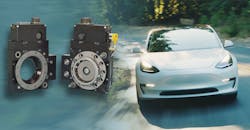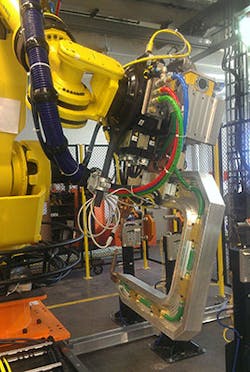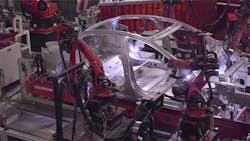Electric Cars Power Growth for Robotic Tool Changers
Chinese-made cars are going electric, and that means new opportunities for the robotics industry.
"One of the things that it will foster is the manufacturing of aluminum vehicles combined with composite materials to keep the weight down," says Robert Little, CEO of ATI Industrial Automation. " ATI plays a strong role in that because they want to use robots to do this work."
In early September, Little visited China, where he spoke with auto manufacturers who discussed their need for robotics to advance the country's growing electric-car industry.
China is installing more robots than any other nation, Bloomberg News recently reported. In 2016, China's annual sales volume reached the highest level ever recorded for a single country, with sales up 27% to 87,000 units, according the International Federation of Robotics
ATI, based in Apex, N.C., manufactures robotic accessories and robot arm tooling, including robotic tool changers. The company has designed its tool changers to handle the complexity of changeovers during welding, an essential function in the production of electric cars, Little says.
The Evolution of Tool Changers
Auto manufacturers can't afford downtime during changeover, particularly in the competitive electric-car industry, Little says. This means tool changing must be a fairly seamless process to meet productivity demands. But robots are inherently single-action machines—they're designed to perform one function.
Automated tool changers were developed about 30 years ago to change tools automatically on robots. Over the years, ATI has enhanced the design of its tool changers to handle the loads that robots produce, Little says.
"Robots are powerful devices, and tool changers have to be as strong as the robot," Little explains. "To do this, we use a pneumatically actuated device that we've perfected over decades, and use pneumatics to lock and unlock the changer."
Robotic tool changing isn't as simple as swapping out a single attachment. It also means changing any utilities that each tool requires.
"For example, if you have sensors on your end effector, you have to pass those sensor signals up through the tool changer, and those signals have to be automatically connected and disconnected," Little says. "We've perfected the ability to pass the electronic signals, weld power, and fluids such as cooling water for weld guns. We've even perfected the ability to pass rivets for tools that are riveting."
In addition, ATI has designed its tool changers to require low maintenance. They will last the life of the line, which is typically five to 10 years, Little says. They also can withstand harsh welding environments where water, heat, and weld debris are often present.
Looking Ahead
The Chinese government plans to set a deadline for automakers to end sales of fossil-fuel-powered vehicles, Bloomberg News reported on Sept. 10. China is subsidizing more than a dozen electric-car companies, according to Little. This includes manufacturers that are not currently in the auto industry, including a solar-panel producer, Little says. The potential for ATI is significant, he says.
"What I've been hearing in China is that they look at Tesla as a model of how to start a business," Little says. "Many of these companies looking to build electric cars are looking to Tesla as an example of what you can do. And, of course, Tesla uses our product in welding.
"The bottom line is: The work that we've done with Tesla goes a long way with these Chinese car companies."
ATI is well positioned in this growth market because of its experience with Tesla, and its focus on designing tool changers that can handle applications in the electric-car industry, Little says. This includes providing set-up expertise to ensure plants are using the company's tool changers properly.
For example, ATI's tool changers typically pass a bus signal, such as Profinet, Ethernet, or DeviceNet. ATI has developed expertise in all three bus systems, so the company can explain proper set-up practices and ensure the bus system is being used correctly.
"Because we're experts in those fields, we can look at their current bus line, and we can see quickly whether it's done correctly or not," Little says. "If it's not done correctly, we can advise on how to properly do it. Our goal is to make sure it's designed correctly because you can't tool change properly on a poorly designed bus system."
ATI also applies its expertise to offer post-sales support, Little says. This includes diagnosing systems that may impact the performance of the tool changer and cause disruptions.
"We have become experts in areas that are outside our tool changer to ensure the tool changer works properly," Little says.
About the Author

Jonathan Katz
Freelance Editor and Writer
Jonathan Katz, owner of JSK Communications, is a freelance writer with more than 15 years of experience in the publishing industry. He is the former managing editor for Cannabis Business Times and Cannabis Dispensary at GIE Media and a former managing editor of IndustryWeek magazine at Endeavor Business Media.
At IW, Katz covered a wide range of manufacturing topics, including automation, safety, facilities/plant operations and executive leadership.
Prior to freelancing, Katz served as a project manager for Content4Demand, a content marketing agency.



